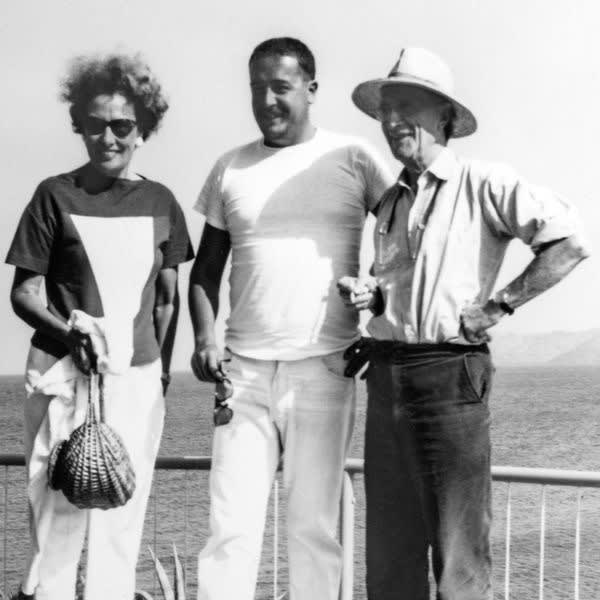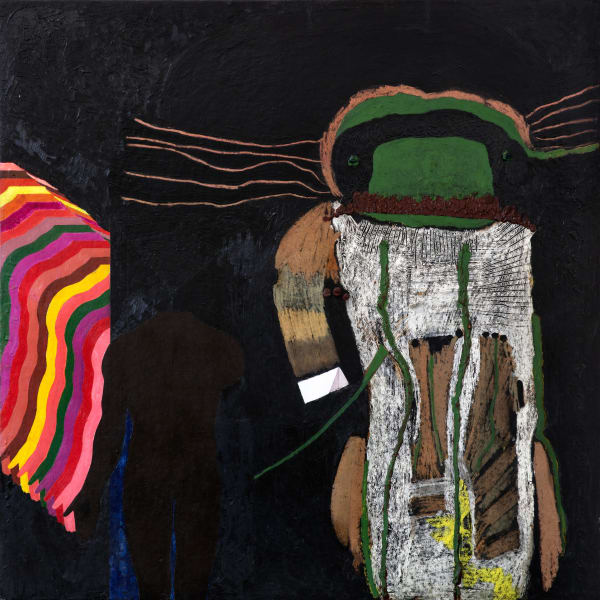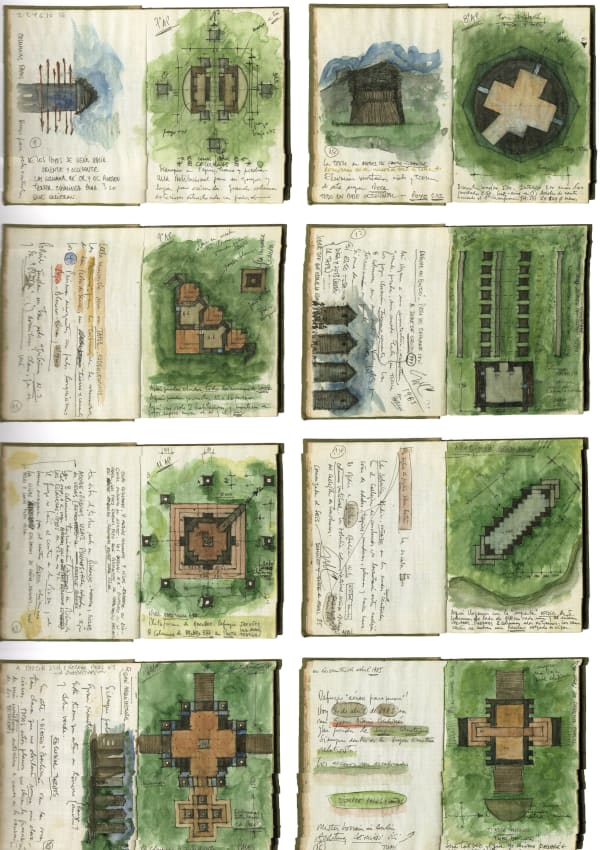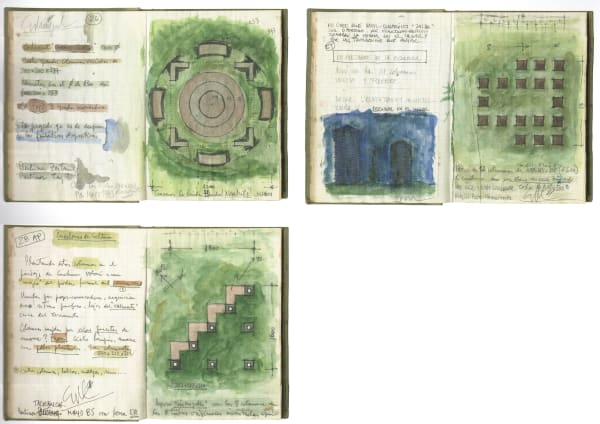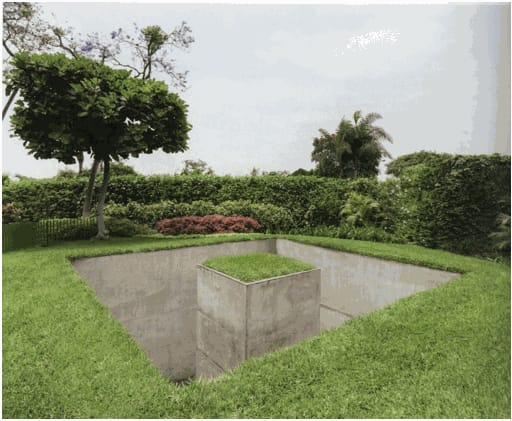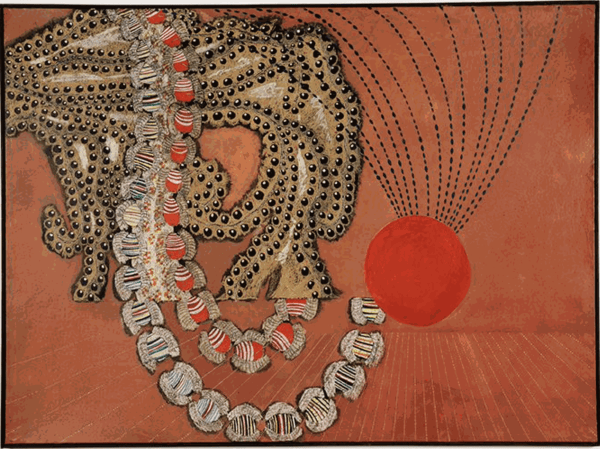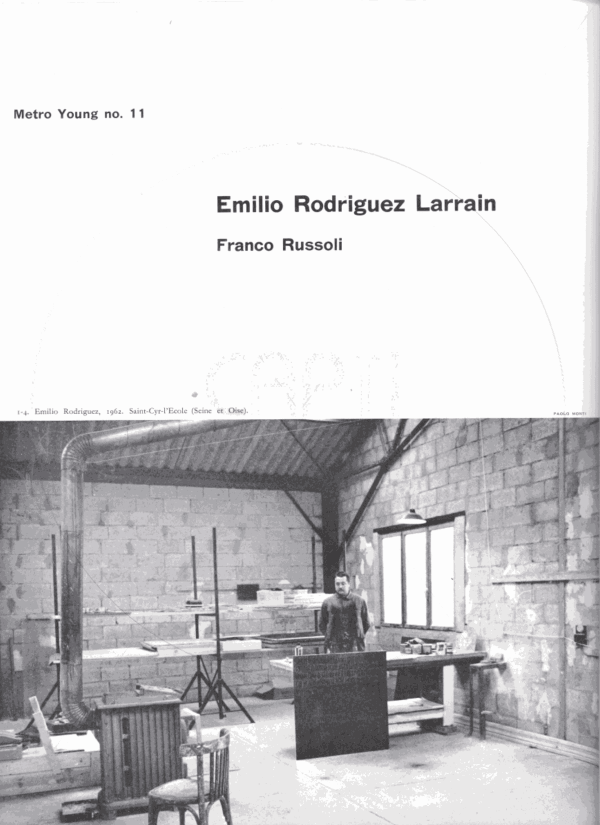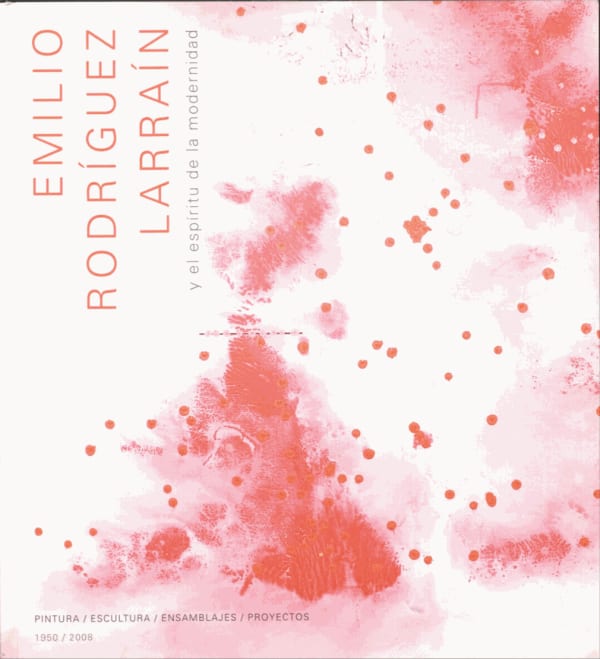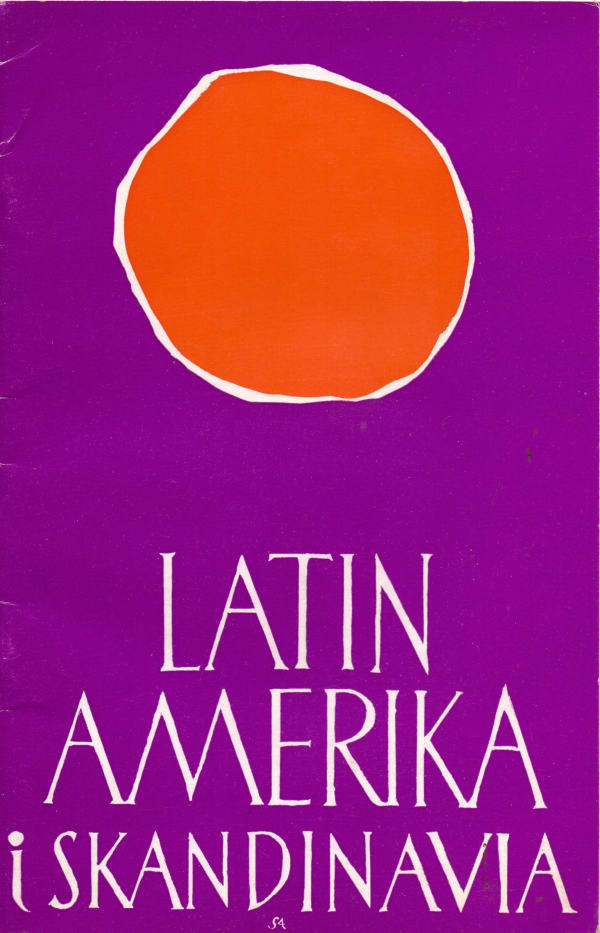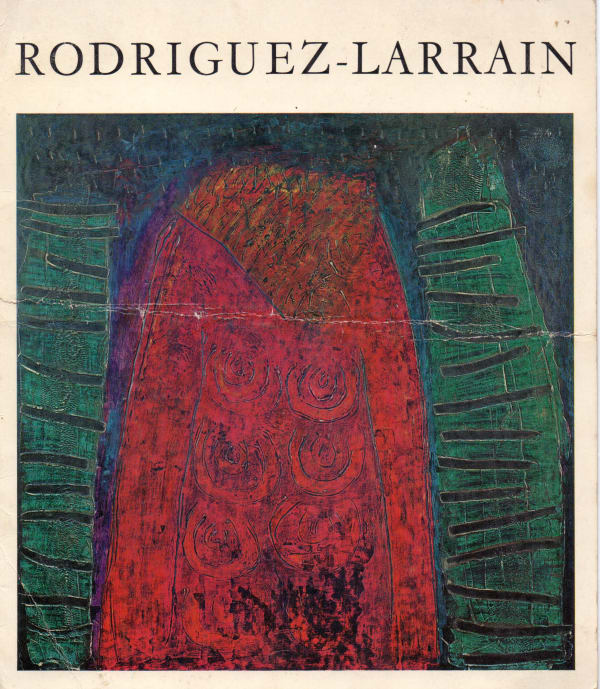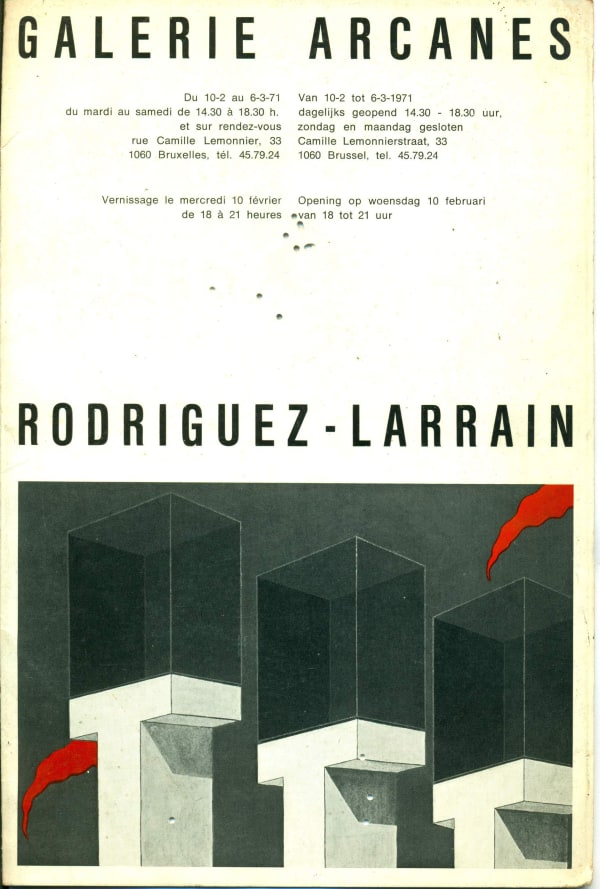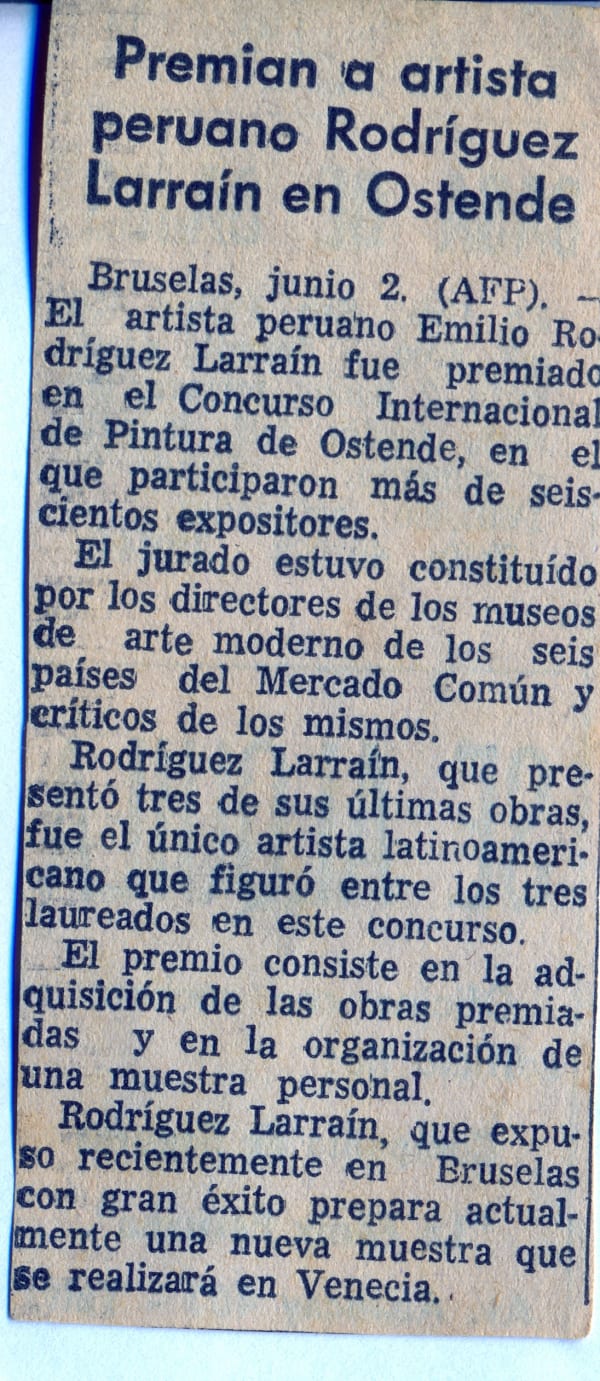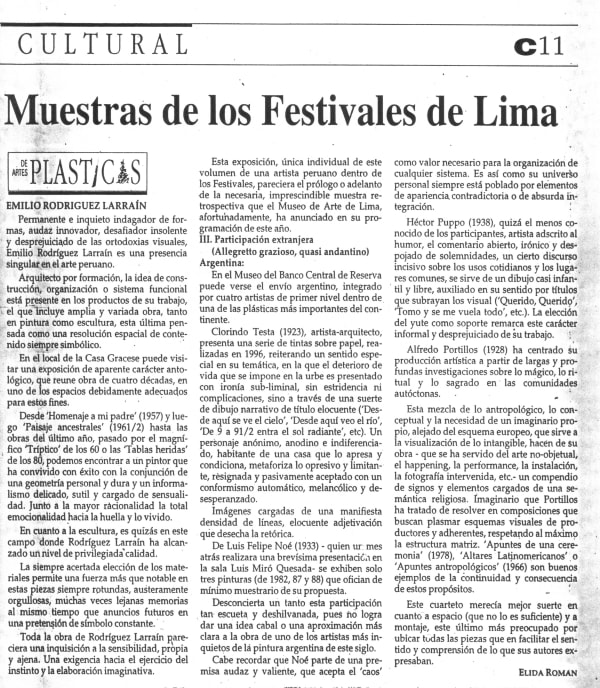-
DOWNLOAD CV
DOWNLOAD EXHIBITION CATALOGUE of Ancestral Landscapes
DOWNLOAD PRESS RELEASE OF ANCESTRAL LANDSCAPES
-
Emilio Rodríguez-Larraín: Ancestral Landscapes
19 October 2023 - 3 February 2024 -
 Photograph of Emilio Rodríguez-Larraín, circa 1961-1962
Photograph of Emilio Rodríguez-Larraín, circa 1961-1962 -
Emilio Rodríguez-Larraín (b. 1928, Lima, Peru - d. 2015, Lima, Peru) was an artist who studied and lived in Europe for three decades and whose practice included painting, sculpture, architecture, and land art. He drew from indigenous, pre-colonial, and geometric Latin American sources while inserting them in his production. In Europe, he became friends with Man Ray and Marcel Duchamp, who influenced his artistic transition to paint with the “guided fate,” in which the artist minimally intervenes with the work and lets chance, or nature, be the protagonist. Towards the end of Rodríguez-Larraín's career, he created large, site-specific sculptures and land art that were inspired by his training as an architect and interest in the environment.
-
Rodríguez-Larraín at Work
-
"Rodriguez-Larrain manages to reinstall himself, despite our western notion of time and space, in a tradition whose door had been closed since the time of the Conquest."
-Translation of Marco Limenes, "La Maquina de Arcilla: La nueva hueca de Huanchaco," Sí, February 1988, Lima, Peru
-
In 1947, Agrupación Espacio, a collective of forward-thinking architects, artists, and intellectuals, initiated a modernist revolution in Peru with a manifesto published in "El Comercio." They called for functionalism and a departure from traditional styles, aiming to align art and architecture with contemporary realities. Among the key figures was professor Luis Miró Quesada Garland, key to shaping Peru's modernist discourse. At this time, 19-year-old Emilio Rodríguez-Larraín, studying architecture at La Escuela Nacional de Ingeniería under the department chaired by Fernando Belaunde Terry, deeply absorbed these ideals. Excelling in his studies, Rodríguez-Larraín won el Premio Regla T in 1949, and by age 21 was on a promising road as an architect. Rodríguez-Larraín, however, designed only one home before making a dramatic shift away from architecture to art, influenced in part by his friend and mentor, Servulo Gutierrez. This transition did not signify, however, a departure from his modernist ideals but rather a continuation in a different medium. As a visual artist, Rodríguez-Larraín's work—spanning painting, sculpture, land art, and installations—continued to embody the modernist spirit, characterized by innovation and universality. His oeuvre is noted for its variety and freshness, continually engaging with space and form in new ways. This dynamic approach has cemented his legacy as a versatile and pioneering figure in 20th-century Peruvian art, inspiring a generation with its boldness and originality.
The following decades text were written by Michele Greet, the Director of the Art History Program, Professor of Art History, and affiliated faculty in Latin American Studies, Cultural Studies, Honors, and Women’s Studies at George Mason University, Virginia. Please click on this link for more information about her.
-
1950s
-Michele Greet“The artist who, like Rodríguez Larraín, takes the path of abstraction proceeds with passion, not only because his attitude entails renouncing any commercial success, but also because it means isolation from the public… he accepts a terrible test, that of tearing from the canvas, only by means of his sensitivity, the truth he is searching for.”-Sebastian Salazar Bondy, “Sobre un Pintor Abstracto," La Prensa, November 29, 1952, LimaAfter studying architecture at the Escuela Nacional de Ingeniería (National School of Engineering) in Lima, Rodríguez-Larraín turned to painting, and in 1951, he started experimenting with geometric abstraction. He made several trips to Europe throughout the decade where his exposure to new tendencies shaped his approach to composition. The Galería de Lima (Lima Gallery), a recently established independent venue for showcasing modern art, sponsored Rodríguez-Larraín’s first solo exhibition of geometric abstraction in 1953, bringing the movement to the public eye and paving the way for a brief surge of geometric abstraction in Peru.[i] A turning point for Rodríguez-Larraín was meeting the French artist Jean Dewasne, founder of L'Atelier d'Art Abstrait (Abstract Art Workshop) in Paris, who was in Peru for a solo show at the Galería de Lima in 1954. In 1956, Rodríguez-Larraín left for Europe once again, exhibiting in Paris, Florence, Copenhagen, and Milan, where he would settle in 1959. Key events during this period were his participation in the Salon des Realités Nouvelles in Paris in 1957 and the groundbreaking I Salon de Arte Abstracto in Lima in 1958.
[i] The same gallery had held exhibitions of Rodríguez-Larraín’s figurative work in 1950 and of his geometric abstractions again in 1955.
-
-

Emilio Rodríguez-Larraín, Untitled, 1956, 73 x 125 cm, Private Collection, Italy
-

Emilio Rodríguez-Larraín, Untitled, circa 1956, 73.5 x 125 cm, Private Collection, Italy
-

Emilio Rodríguez-Larraín, Untitled, 1957, 73 x 125 cm, Private Collection, Italy
-

Emilio Rodríguez-Larraín, Nasha 3, 1957, 76.1 x 63.4 cm, Collection of Jorge Basadre and Mariana Moreyra
-
-
In the mid-1950s, Rodríguez-Larraín emerged as a pioneering proponent of geometric abstraction in Peru and was among the first to exhibit such works in Lima.[i] Although Peruvian artist Fernando de Szyszlo exhibited abstract paintings in 1951, Rodríguez-Larraín’s hard-edged style diverged from Szyszlo’s softer, more organic works, and marked his bold endorsement of the post-war international fervor for constructivism. Irregular geometric shapes rendered in vibrant contrasting colors form intricate patterns in Rodríguez-Larraín’s geometric abstractions from the 1950s. While firmly associated with the international propensity for such imagery, his compositions are unique in their subtle balance of shapes painted in intense hues several shades removed from primary colors. His wine-tinged reds, sky blues, autumn oranges, and golden yellows scintillate as the sharp edges of forms align. His arrangement of flat colored shapes establishes balance between rhythmic striated bands, half circles, angles in varying sizes, and invented forms that are simultaneously precisely composed and highly dynamic.
[i] Several other artists were experimenting with geometric abstraction in Lima (such as Benjamin Moncloa, Jorge Piqueras, Luis Lopez Paulet, Emilio Goyburu, José Bracamonte, and Aníbal Santiváñez), but Rodríguez-Larraín was the first of these artists to exhibit his geometric abstractions in Lima.
-
 Emilio Rodríguez-Larraín with his Painting, 1950s
Emilio Rodríguez-Larraín with his Painting, 1950s -
 Emilio Rodríguez-Larraín at Casa Lavalle
Emilio Rodríguez-Larraín at Casa Lavalle -
Friendship with Man Ray
-
1960s
-Michele Greet“The finished paintings, luminous, vaguely geometric patterns contrasted with black pools of fear and despair, present an integrated totality. We are reminded…of Aztec design and South American color, but the reference is almost always a spiritual one rather than a tangible, visual one.”
-Rodriguez-Larrain, Staempfli Gallery, January 12-30, 1965, New York
Rodríguez-Larraín’s reputation took off in the 1960s. During this period, he lived in various European cities and participated in numerous group and solo exhibitions in Italy, Germany, France, Belgium, and the United States, where he was represented by the Staemplfi Gallery located at 47 E. 77th St. in New York. In 1960, Rodríguez-Larraín met Marcel Duchamp and the two artists became close friends and collaborators. Duchamp introduced Rodríguez-Larraín to key players in the global art world and nurtured his experimental practice. Major museums and collectors began paying attention to his work; he participated in four group shows at MoMA, and both MoMA and Nelson Rockefeller acquired his work. While he resided primarily in Europe, Rodríguez-Larraín made several visits to Peru (1963, 1964, and 1967), reinforcing the relevance of abstract art in his home country. In Lima, the Instituto de Arte Contemporáneo (Institute of Contemporary Art) had replaced the Galería de Lima as the leading tastemaker and exhibition venue in the city. The IAC organized the Peruvian delegation to the 1964 Venice Biennale by choosing the most important abstract artists to represent the country (Rodríguez-Larraín [who was also previously selected for the 1960 Venice Biennale], Alberto Dávila, Jorge Eielson, Jorge Piqueras, Joaquín Roca-Rey, and Fernando de Szyszlo), validating ancestralismo, a trend in contemporary Andean painting that sought inspiration in the abstract motifs, colors, and patterns found in pre-Columbian art, on the world stage. Rodríguez-Larraín also held a joint exhibition at the IAC with the Italian abstract painter Guido Strazza that same year. It was Rodríguez-Larraín's 1967 exhibition at the editorial house Francisco Moncloa where he exhibited thirty-two works created between 1959-1965 that marked his local triumph, however.
-
-

Emilio Rodríguez-Larraín, Untitled, 1960, Oil on canvas, 50 x 50 cm
-

Emilio Rodríguez-Larraín, Architecture pour rever (Dream Architecture), 1961, Oil on board, 63.5 x 63.5 cm
-

Emilio Rodríguez-Larraín, La Ventana alucinada (The Hallucinated Window), 1963, Mixed media on wood, 99.6 x 99.6 cm, IAC Collection in the Museo de Arte Contemporáneo, Lima, Peru
-

Emilio Rodríguez-Larraín, Sin título con esferas blancas (Untitled with white spheres), 1963, Mixed media on cardboard, Collection of Lucrecia Rodríguez Larraín, Miami
-
-
In 1959, inspired by informalist movements in Europe, Rodríguez-Larraín’s forms became more organic, his palette shifted toward earth tones, and texture became a major element in his compositions. He began employing tempera and wax and burning and scratching the surface of his canvases to create new effects. He often worked on a deep black ground, slowly building layers of color and pattern. Unlike many of his contemporaries in Europe and the U.S., Rodríguez-Larraín’s approach was not gestural; instead, he painted intricate linear patterns, rich mixtures of color, and meticulous details. Occasionally, his titles alluded to Peruvian culture and geography (i.e., Magic Mamapacha, Ancestral Landscape, Viceroy, or Ranrahirca), loosely aligning his work with ancestralismo. While Rodríguez-Larraín did not directly emulate specific objects or archaeological sites, his forms prompted viewers to imagine a visual connection across time and to perceive references to the archaic and mythical in his work. Andean textile traditions were often a source of inspiration. In La Ventana Alucinada (The Hallucinated Window), for example, the multiple lines emanating from a central gridded square resemble the cords used in quipus, Incan communication devices made of knotted string that were used to record and transmit information.
-
Latin-American Art, 1931–1966, from the Museum Collection
The Museum of Modern Art (MoMA), March 17 – June 4, 1967 -
Twentieth-Century Art from the Nelson Aldrich Rockefeller Collection
The Museum of Modern Art (MoMA), May 28–September 1, 1969 -
 On the left wall: Rodríguez-Larraín, "Manola triste con mantilla y claveles," 1961, Mixed media on paper, 39 x 39 in
On the left wall: Rodríguez-Larraín, "Manola triste con mantilla y claveles," 1961, Mixed media on paper, 39 x 39 in -
 Emily McFadden (Collector and Spouse of George Staempfli), Emilio Rodríguez-Larraín, and Marcel Duchamp, courtesy of the Estate of Emilio Rodríguez-Larraín
Emily McFadden (Collector and Spouse of George Staempfli), Emilio Rodríguez-Larraín, and Marcel Duchamp, courtesy of the Estate of Emilio Rodríguez-Larraín -
Duchamp's Influence on Rodríguez-Larraín's Work
-
Letter from Marcel Duchamp to Rodríguez-Larraín
-
Chess Tournament Shenanigans with Marcel Duchamp and Man RayIn this video, Herman Braun-Vega, an artist and friend to Emilio Rodríguez-Larraín, discusses a 1963 chess tournament in Llança, Spain, reserved only for Spaniards. Despite this rule, Rodríguez-Larraín decided to bring his non-Spaniard friends, Marcel Duchamp and Man Ray, to compete. When he registered them for the tournament, he listed Man Ray's name as Manolo Rayo and Duchamp's name as Marcelo del Campo. Rodríguez-Larraín also lied and said they were both deaf mutes, so that the Spaniards wouldn't identify their accents. He executed the whole scheme, and Duchamp and Man Ray finished respectively in 1st and 2nd place.
-
1970s
-Michele Greet“His marbles and woods emit the restrained luminosity of altars mastered by geodesic religions […] Within the masterful assemblages, internal clarity initiates the slow vibrations of an awakened self-understanding. Weights tilt. Oblique angles offer problems so disproportionate that only a second-degree geometrization will be able to permute interstitial ethers and visual thoughts.”
-Jean Dewasne, Emilio R. Larrain. Sculptures – Peintures, L’Enseigne du Cerceau, 1975, Paris
The 1970s was the decade of sculpture. In 1969, Rodríguez-Larraín produced his first metal sculptures and continued creating wooden objects. In 1971, he won the Prix de l’Europe in Ostend, Belgium, for his geometric painting Trois Tigres Triste (Three Sad Tigers), where he was one of 600 artists competing and the only Latin American winner. During this period, he held individual and group exhibitions in Italy, France, Spain, Belgium, Norway, and Peru, which included his first solo show of sculptures at the Galerie à l’Enseigne du Cerceau in Paris in 1975. One year later he received a Guggenheim grant to primarily work on sculpture, while he also developed his seminal series Cuadros del Cielo (Sky Paintings). The jury included Dore Ashton, Donald Judd, Robert Motherwell, and Frank Stella, and Rodríguez-Larraín's success was a testament to his status as international abstract artist. The 1970s also saw his participation in another Venice Biennale (1972) and the XXX Salon des Réalités Nouvelles.
-
Rodríguez-Larraín’s color palette became more vibrant and energetic in the paintings he completed in the 1970s. But his primary innovation during this decade was in sculpture. Creating small scale objects out of wood and steel, Rodríguez-Larraín returned to the geometric forms of his paintings from the 1950s. His sculptures, however, were symmetrical and balanced, minimalist objects based on the core geometries of cubes and pyramids. Often made in multiple editions using different materials, Rodríguez-Larraín’s precise designs reflect his early training as an architect. The refined craftsmanship, weightiness, and high-quality materials of these objects imply that they hold iconic or mythical significance. Rodríguez-Larraín’s Sky Painting series of 1976-77 went in a different direction altogether. Employing the surrealist technique of controlled chance, he treated canvases with casein then dyed them with dirt and regional fruit and left them to dry on his roof for three months. Inspired by the resulting stains on the surface, Rodríguez-Larraín superimposed shapes, lines, and collage elements to suggest celestial maps. The contrasting techniques of his meticulously planned sculptures and the chance effects in his paintings represent the two poles of artistic experimentation that characterized the era.
-

-
Julio Roman Ribero, Los Cuadros del Cielo (Sky Paintings)Julio Ramón Ribeyro Zúñiga, the well-known Peruvian writer and friend to Rodríguez-Larraín, wrote his understanding of Cuadros del Cielo (Sky Paintings) below.
-
Former MoMA Curator Dorothy C. Miller's Recommendation for 1976 John Simon Guggenheim Memorial Foundation Fellowship
-
"Dorothy Canning Miller was the first professionally trained curator hired at the Museum of Modern Art, which she joined in 1934, joining in a staff of thirteen (including a receptionist, a switchboard operator, and a man at the front desk who sold postcards and catalogues). In a field dominated by men, Miller’s rapid evolution into America’s first museum curator of contemporary art was not without setbacks, but she persevered: at MoMA she became the pivotal curator of her generation, championing American artists at a time when few curators were paying any attention to them."
-Wendy Jeffers, Former Chair of the Board of Trustees of the Archives of American Art
-
Rodríguez-Larraín's Early Land Art
Cubo Encinta -
 Emilio Rodríguez-Larraín, "Piramidita," 1977, Blued steel, 21 x 21 x 26 cm
Emilio Rodríguez-Larraín, "Piramidita," 1977, Blued steel, 21 x 21 x 26 cm -
Milpatas
-
1980s
-Michele Greet“I think that, more than provoking us with his sculpture, using both ancient and new tools, he seeks to reintegrate us into a dialogue with this vast arid and amazing Peruvian coast where many other ‘clay machines’ still lie—invisible…he makes use of a supposed ‘contemporary language’ to unravel mysteries, myths and pre-Hispanic symbols.”
-Marco Limenes, “La Máquina de Arcilla: La nueva hueca de Huanchaco,” Si, Feb. 1988, Lima
In 1981, Rodríguez-Larraín returned to Lima, bringing most of the work he created in Europe with him. There, he began focusing on monumental sculpture and earthworks, constructing pieces, such as Apacheta along the Pan-American highway in 1986 and La máquina de arcilla (The Clay Machine) for the III Bienal de Trujillo on the beach of Huanchaquito. He showed at the Galería 9, the Galeria Camino Brent, and the Galería Forum, new venues for contemporary art exhibitions in the city, and participated in a retrospective of Peruvian abstract art with other prominent artists including Moncloa, Piqueras, and Szyszlo. Rodríguez-Larraín remained engaged with the European art scene and participated in exhibitions in Germany and Spain. In 1985, he received a grant from the Deutscher Akademischer Austauschdienst (German Academic Exchange Service) to work on a series of designs for one of his most monumental projects titled Refugios de los Andes (Andean Refuges).
-
-

Emilio Rodríguez-Larraín, Refugios de los Andes 6 (Andean Refuges 6), 1985, Mixed media on canvas, 139 x 130.5 cm, Private Collection, Lima, Peru
-

Emilio Rodríguez-Larraín, La máquina de arcilla (The Clay Machine), 1987, Photograph, Private Archive, Lima, Peru
-

Emilio Rodríguez-Larraín, Refugios de los Andes 1 (Andean Refuges 1), 1985, Mixed media on canvas, 141 x 130 cm, Museo de Arte de Lima, Lima, Peru
-

Emilio Rodríguez-Larraín, Apacheta, 1985-1986, Photograph, Museo de Arte de Lima, Lima, Peru
-
-
Drawings for "Refugio de los Andes"
1985, Watercolor and ink on paper, 21.5 x 15.6 x 2 cm, Archive, Lima, Peru -
 Emilio Rodríguez-Larraín, Un cuarto de escultura, 1986, Galería de Arte Camino Brent, Caretas Archive
Emilio Rodríguez-Larraín, Un cuarto de escultura, 1986, Galería de Arte Camino Brent, Caretas Archive -
In the 1980s, Rodríguez-Larraín turned his attention to designing and building monumental earthworks. Conceived in collaboration with his daughter Sofía, Rodríguez-Larraín’s Andean Refuges consist of plans for thirteen shelters to be built along mountain roads in Peru. While never realized because of the presence of the Shining Path, the designs enlarge structures analogous to his geometric sculptures to a human scale. Employing interlocking positive and negative spaces, these architectural interventions in the landscape recall sacred Incan tambos. Similarly, his site-specific sculpture Apacheta, a cairn constructed of stone, refers to the sacred markers built throughout the region during the Inca empire. Rodríguez-Larraín’s Apacheta consists of a pile of three large craggy rocks in the Ica desert that rise above the coastal landscape, a work that is both a modern intervention and a recollection of past practices. With The Clay Machine, Rodríguez Larraín transitions to a truly monumental scale. Using traditional materials of adobe and mud, Rodríguez-Larraín creates a structure that recalls the pre-Hispanic ruins of Lima, such as Chan Chan, Huaca Pucllana, and Huaca Huantille. These earthworks push the notion of ancestralismo, a trend in contemporary Andean painting that sought inspiration in the abstract motifs, colors, and patterns found in pre-Columbian art, beyond painting to create structures that resonate with the local landscape and culture.
-
1990s-2000s
-Michele Greet“An exceptional artist. It seems that sensitive intuition and a capacity to generate forms are the only things that triggered a creative ability that, ignoring canons, invents its own routines, facilitates the birth of new forms and achieves, in this creative and often endless exercise, works ranging from rigorous and carefully-planned constructions to a mastery and guidance of chance emphasized through a gesture.”
—Elida Roma, “An exceptional artist,” El Comercio, Feb. 2007
-
Rodríguez-Larraín remained active during the last decades of his life, completing several monumental projects. Most significantly, in 1991, he participated in the exhibition Man Ray and his Friends in Japan, which also included works by renowned modernists such as Duchamp, Ernst, Picasso, Miró, and Breton. In 1992, Rodríguez-Larraín moved to Coral Gables, Florida, but frequently returned to Lima to exhibit. In 1998, he returned to Lima and was granted to opportunity to build one of his Andean Refuges in the garden of the Museo de Arte de Lima (Lima Art Museum) for the Bienal Cosapi de Arte y Empresa (Cosapi Biennial of Art and Buisness). Starting in 1997, several retrospective exhibitions of his work were organized, the most significant of which was held in 2007 at El Instituto Cultural Peruano Norteamericano de Lima (The Peruvian-North American Cultural Institute of Lima). In 2005, his work was recognized with Medalla Ignacio Merino from the Municipalidad de Lima (Ignacio Meriano Medal from the Municipality of Lima), and in 2006, he won the Premio de la Bienal de Pintura Teknoquímica (Teknoquímica Painting Biennial Prize). Rodríguez-Larraín passed away in Lima in 2015.
-
Man Ray et ses amis
1991, Itami City Museum of Art, Akita Senshu Museum of Art, Okayama Prefectoral Museum of Art, Tsukuba Museum of Art, Takamatsu City Museum of Art, and Bunkamura Museum of Art -

-
Impossible Blossom: Paintings from The New School Art Collection
June 23 – September 8, 2016, Kellen Gallery, Sheila C. Johnson Design Center, Parsons The New School for Design, New York"Most of the art in The New School Collection has a clear, understandable, although not always defensible, provenance. Historically, art comes into the collection one of two ways: gift or purchase. There is usually a fairly accurate accounting of who gave, what they gave, when they gave, and sometimes why they gave. In the case of the painting by Emilio Rodriguez-Larrain, however, we can only guess the provenance based on the labels attached to the back of the painting. They tell us two things: the painting hung in the 1964 Venice Bienniale and it was purchased at auction sometime after that date. Who, when, and why are a total mystery.
Rodriguez-Larrain’s painting, the title of which translates to Man is Subject to Wander, may be understood by way of the artist’s biography. Rodriguez-Larrain was born in Lima, Peru in 1928, but lived and worked for periods of time in Paris, Milan, and Berlin. He initially studied architecture at the Universidad de Ingeniera in Peru and his early more geometric works reflect his architectural training. He later synthesized the influences of traditional Peruvian image-making with the European Modernism he encountered on his travels. He was known to have made contact with several influential artists of the time including Dali, Man Ray, and Duchamp.
L’Homme est Sujet a Errer embodies that influence: its strange shapes are evocative, on the threshold of being recognized as things from the world, but ultimately resist identification. His use of flat, smooth surfaces punctuated by patterning echoes European Surrealism with its enigmatic, impenetrable surfaces. The psychedelic, other-worldliness of this painting captures the wonder of nature with its biomorphic forms and saturated atmospheric vibrations."
-Wall Text from Impossible Blossom: Paintings from The New School Art Collection
-
 Emilio Rodríguez-Larraín, Refugio de los Andes 1, 1985, Mixed media on canvas, 140.3 x 130 cm, Museo de Arte de Lima, Lima, Peru
Emilio Rodríguez-Larraín, Refugio de los Andes 1, 1985, Mixed media on canvas, 140.3 x 130 cm, Museo de Arte de Lima, Lima, Peru
-
Emilio Rodríguez Larraín, pintor y escultor peruano
TVPeru -
Publications
-

Metro Young no. 11: Emilio Rodriguez Larrain
The art historian Franco Russoli discusses Emilio Rodríguez-Larraín's art and practice. -

Peru. Partecipazione all 32ma. Biennale internazionale d`arte Venezia
Emilio Rodríguez-Larraín participated in the 1964 Venice Biennale. -

Emilio R. Larrain. Sculptures et peintures
Galerie L'Enseigne du CerceauEmilio Rodríguez-Larraín's solo exhibition at the Galerie L'Enseigne du Cerceau, Paris, France -

Emilio Rodríguez Larraín y el espíritu de la modernidad
Pintura/Escultura/Ensamblajes/ProyectosA solo exhibition at the Galería de Arte del Cultural - Arequipa -

Gerardo Chavez y Emilio Rodriguez Larrain
Trilce, Galeria de ArteA two-person exhibition at Trilce in Lima, Peru -

Rodríguez-Larraín
Exhibition catalogue for La RodriguezLarrain at Galleria Numero -

European Prize for Painting
OstendEmilio Rodríguez-Larraín was selected for the 1971 Prix de l'`Europe in Ostend, Belgium. -

Latin Amerika I Skandinavia
A traveling Latin American art exhibition in Scandinavia -

Painting and Sculpture Today
-

Recent Acquisitions
StaempfliA survey of exhibitions held at Staempfli Gallery from 1962 to 1963 -

Rodriguez-Larrain
-

Rodriguez-Larrain
-

Rodriguez-Larrain
Galerie ArcanesA gallery exhibition catalogue from the Galerie Arcanes -

Emilio Rodriguez-Larrain, Skulpturenprojekte für die Anden
Berliner Künstlerprogramm des DAAD -

Dedicatoria
Museo del Grabado ICPNAExcerpts from Emilio Rodríguez Larraín's retrospective exhibition at the Museo del Grabado ICPNA -

Man Ray et ses amis
Rodríguez-Larraín participated in the exhibition Man Ray and his Friends in Japan, which also included works by renowned modernists such as Duchamp, Ernst, Picasso, Miró, and Breton. -

Antes de América
Fuentes originarias en la cultura modernaFundación Juan March's group exhibition Antes de América included Emilio Rodríguez-Larraín. -

Arte, Paisaje y Desierto: Emilio Rodríguez-Larraín y La máquina de arcilla (1987)
'The relationship that Peruvian women and men have established with the desert has changed over time. Much of this relationship is reflected in the footprints they left on this sandy...
-
-
Press
-

Emilio Rodriguez Larrain, Expreso
October 2, 1962 -

Rodriguez Larrain
A description of Emilio Rodríguez Larraín's exhibtion in 1958 -

Rodriguez-Larrain, L'Aurore
February 2, 1971A description of Emilio Rodríguez Larraín's exhibition at the Galerie Arcanes in 1971. -

Rodriguez Larrain alla "Lorenzelli," L'Eco di Bergamo
-

Inaugura Rodríguez Larraín: Dos nuevas exposiciones
A description of Emilio Rodríguez Larraín's inaugural exhibition at Galeria 'Moncloa.' -

Premian a artista peruano Rodríguez Larraín en Ostende
Emilio Rodríguez Larraín's award from the Concurso Internacional de Pintura de Ostende -

Peruano Rodríguez Larraín Expone Cuadros en Bruselas
A discussion of Emilio Rodríguez Larraín's inaugural exhibition at the galería 'Arcanes' in 1976 -

La cultura no es Emilio Rodríguez Larraín...
October 20, 1982A discussion of Emilio Rodríguez Larraín's poetic attitude towards his artistic practice -

Le Mostre: Larrain, Il Giorno
April 17, 1960A discussion of Emilio Rodríguez Larraín's second exhibition in Italy at the galleria del Milione -

La nueva huaca de Huanchaco
A discussion of Emilio Rodríguez Larraín's sculptural ensemble -

Peruano Gana Concurso Belga De Pintura
Emilio Rodríguez Larraín was awarded in the Concurso Internacional de Pintura de Ostende. -

Un Peruvien de Provence
Emilio Rodríguez Larraín discusses his transition from architecture to painting. -

Muestras de los Festivales de Lima
A discussion of Emilio Rodríguez Larraín's presence in peruvian art -

Sobre Tres Pintores Predilectos Y Acerca De Cada Uno
-

Piedra en la Piedra
October 13, 1986A discussion of Emilio Rodríguez Larraín's artistic practice -

Art in Washington
February 17, 1963A discussion of Emilio Rodríguez Larraín's work and exhibition at the Obelisk Gallery -

Experto belga alaba la playa "Lomitas", futuro balneario
A description of Emilio Rodríguez Larraín's project to create a monument -

Emilio Rodríguez Larraín: artista peruano es honrado en dos continentes
December 4, 2023Alfonso Rivadeneyra García discusses Rodríguez-Larraín's recent international renaissance due to his solo exhibition at HM&C, New York, and his participation in a group exhibition at Fundación Juan March, Madrid. -

Emilio Rodríguez-Larraín’s Andean Modernism
January 29, 2024Read Ela Bittencourt's review 'Emilio Rodríguez-Larraín’s Andean Modernism' in Hyperallergic. -

The Legacy of Rodríguez-Larraín
February 28, 2024'As sullen and elusive as he was indisputably brilliant, Emilio Rodríguez-Larraín Balta (Lima, 1928 - Chorrillos, 2015) was a multiple man: architect, painter, sculptor and installer, he represented us [Peru]...
-























